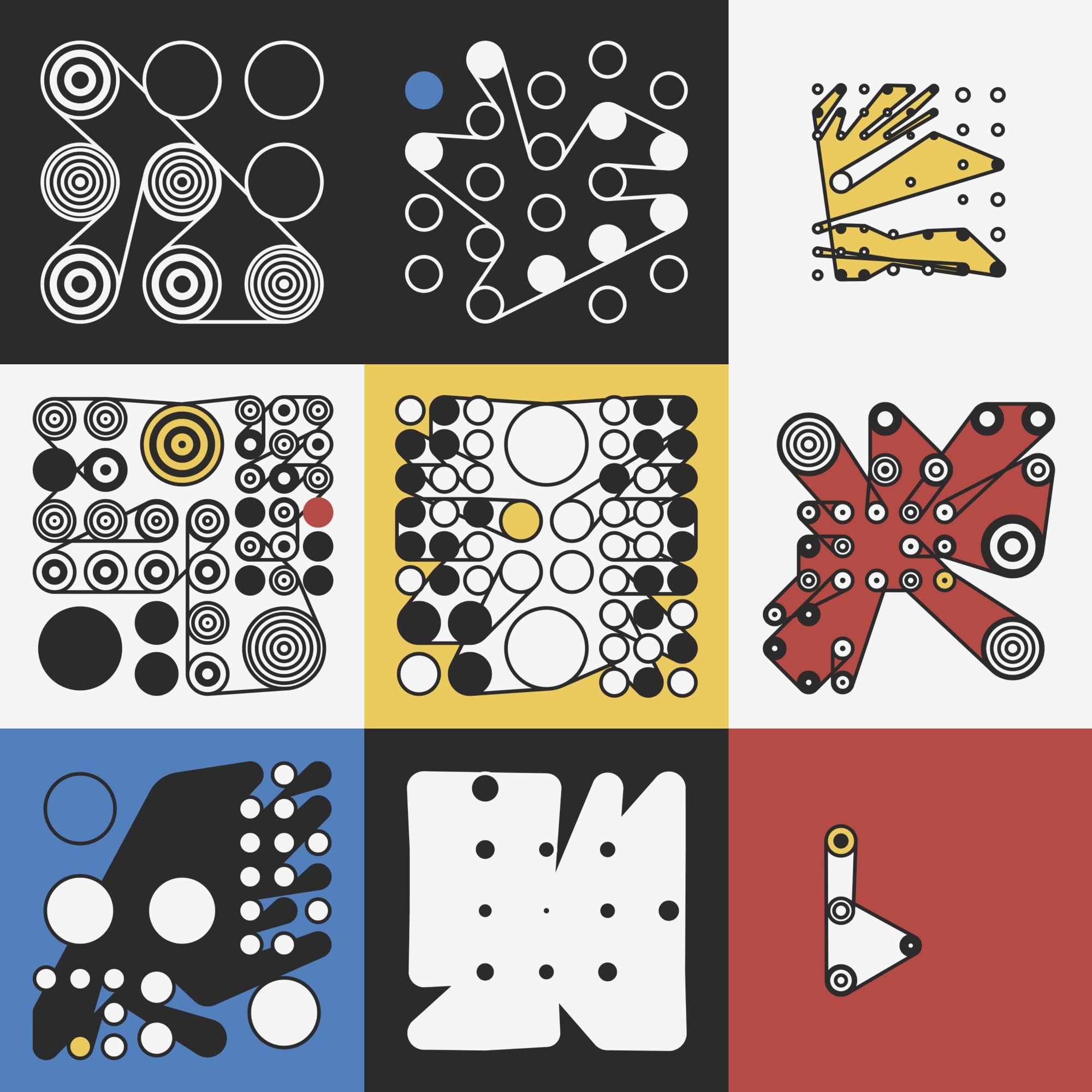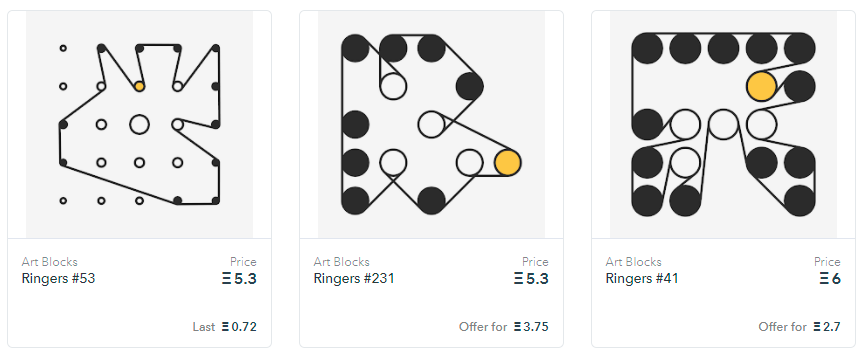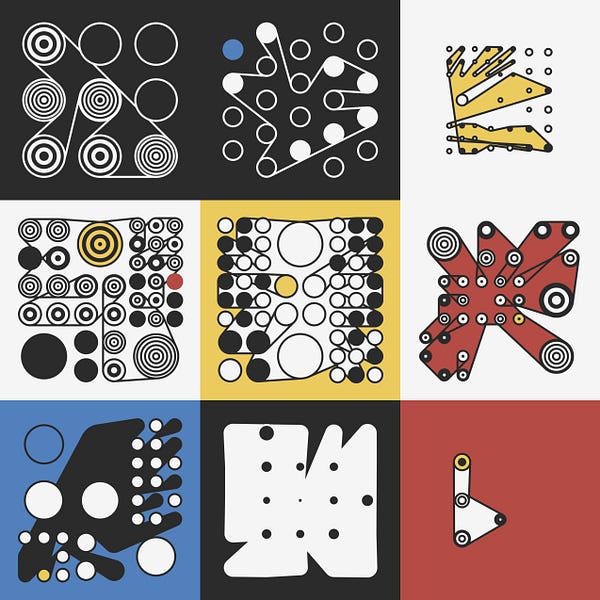Dear Bankless Nation,
Artists using automation via tools like algorithms to create randomized artworks is what we call generative art.
As the world grows increasingly digital and algorithmic in the decades ahead, the cultural significance of generative art will surge. Why? People will cherish these works as some of the early Information Age’s most expressive and exemplary art objects.
Combine generative art’s possibilities with Ethereum + NFTs, and you have the makings of a 21st-century artistic revolution.
In today’s post, then, we’ll be talking about — and talking to — artist Dmitri Cherniak. Released via on-chain generative NFT platform Art Blocks, Cherniak’s masterful generative art series “Ringers” just crossed $1M (+640 ETH) in sales after being released only 3 weeks ago! That’s really impressive, and it paves the way for more generative artists to embrace NFTs, too.
-WMP
Ringers — a Generative Cryptoart Phenom
The Ringers series is composed of 1,000 generative art NFTs. Each of these works is unique though they were all created by Cherniak’s special p5js script, which the artist worked on for years and which is immutably stored on Ethereum via Art Blocks.
When Ringers launched, collectors purchased NFTs that each contained unique seeds. The seeds affected variables in the Ringers script, meaning the series’s outputs, or aesthetics, were randomly determined at minting by these seeds. This led to truly mesmerizing results, as seen for example in these very rare Ringers below!

As Cherniak explains on the Art Blocks site:
“There are an almost infinite number of ways to wrap a string around a set of pegs. On the surface it may seem like a simple concept but prepare to be surprised and delighted at the variety of combinations the algorithm can produce. Each output from 'Ringers' is derived from a unique transaction hash and generated in Javascript in the browser. Feature variations include peg count, sizing, layout, wrap orientation, and a few colorful flourishes for good measure.”
So across the board, both on the inside and outside, Ringers is quite compelling. And the NFT collectors community certainly thinks so, at least if their transactions over the last 3 weeks are any indication!
That’s because the 1,000 Ringers sold out at 0.1 ETH each within 20 minutes of the series being released on Art Blocks, and since then the secondary marketplace around these NFTs has exploded.
Indeed, in combo with the ETH price surge last week, we’ve now seen over 640 ETH and thus ~$1M spent on Ringers. The Ringers price floor on OpenSea has hit 5.3 ETH and is rising fast, too.

It’s a major achievement for Cherniak as an artist and for the generative art field as a whole. There’s a new way forward with Ethereum + NFTs, a way that empowers generative artists to make and release art on their own terms.
Accordingly, I thought it was a perfect time to sit down and pick Cherniak’s brain a bit on how Ringers has fared so far and what the project represents for the artist. He kindly fielded my questions, and his answers were very insightful so be sure to check out the Q&A below. This is certainly the right time to be studying cryptoart pioneers like Cherniak and learning from their trailblazing experiences, so enjoy!
Talking Ringers with Dmitri Cherniak
WMP
Dmitri I wanted to start by saying congratulations, we’ve now seen over $1M spent on Ringers! Wow! I know we’re in uncharted territory when it comes to NFTs generally speaking, but this is a huge achievement for an artist in any context.
Do you think Ringers has marked something of a turning point for your work? Or has this been more like an artistic experiment that’s yielded really interesting results?
Dmitri Cherniak
Ringers has been the culmination of a few years of work on my end. I’ve been creating algorithms to automate the wrapping of a string around a set of pegs and playing with many different peg layouts and ideas, but Ringers was really the first time that I applied all of those forms into one single series and unleashed the power of generative art and blockchain technology together.
I like to say that “automation” is my artistic medium and this project let me realize my artistic vision from start to finish; from sale via smart contract, to art generation using a unique transaction hash, Javascript stored on chain running in the browser, to delivery of goods using tokens sent to wallets. My “art” was about making sure someone could get an interesting and unique piece of work without any human interaction.
I think this has marked a turning point for me personally because I’ve never been able to achieve my artistic vision around the automation of art so clearly.
Prior to this launch many generative artists may have associated the “Ringers” look with my style, but it had never been unleashed in such a raw way without any kind of human curation on my end, besides tending to the limits of the parameters that go into the algorithm.
WMP
Before the release of Ringers on Art Blocks, you worked on the project for a few years. What’s it like stepping back now and seeing how far Ringers has come? What’s surprised you along the way?
Dmitri Cherniak
I always knew it was special. Normally I can put an algorithm together within a few hours and have something interesting, but I spent 2 days figuring out this one and pushing through coding before I was even able to get a single output from it.
Over the past few years I’ve created a number of pieces that rely on the core concept of Ringers and have found it to be a rather adaptable and fascinating form.
Stepping back it’s rather interesting because I have always seen generative art as something that should be appreciated by larger audiences, particularly technologically savvy ones.
One of the most wonderful surprises is that the most beautiful and interesting insights often come from bugs in the code. Compared to coding in solidity and smart contracts, where a small bug can create financial ruin, a bug in generative art can create unexpected levels of beauty. So throughout the process I have observed those bugs and turned them into features of the art.
Even looking through Ringers now, I am surprised at some of the forms I see.
WMP
You’ve spoken previously on how code reusability is a means of developing style in generative art. I think that’s one big reason why Ringers has been such a hit with people, your style in the series is so iconic and delightfully minimal. Even if I had no idea who created them, the pieces would automatically pull my eyes in. Yet now when I see a Ringer I go, “Oh yes, another great Cherniak.”
When you were creating the series, what was sort of going through your head on style? Did you have specific approaches in mind, or was it more like gardening — “plant the seeds and see what grows” — sort of thing?
Dmitri Cherniak
I think a lot of generative art is somewhat bland, including my own sometimes. Generative Art is great for smooth clean lines and geometric art, but it’s really hard to give you that organic feel with curves and colors so once you have something that does work, it’s worth exploring more and using reusable code helps a lot to do that. In this case, I had a lot of experience working with the form so I took a lot of those lessons I’d learned through trial and error and applied them here.
In terms of style, I was mostly concerned with trying to make sure every single output would be unique, look interesting, and be perceived as “worth it.”
From a historical perspective I did a lot of research on the form and it turns out Armin Hoffman wrote a book in the 1960s about design systems called Graphic design manual that actually explores a similar concept. He himself however was not able to automate it, and so could not explore it as deeply as I have with parameters and automation.
WMP
I think what Art Blocks is doing with generative art releases like Ringers has historical significance. Do you see it that way, too? What would you say to other generative artists who maybe aren’t crypto or NFT savvy yet but are starting to hear about this new way of releasing art?
Dmitri Cherniak
Many artists I respect had been quite skeptical beforehand, but after the launch have said it felt like a historic moment for generative art. For the first time as far as I can tell, folks can see the spread and variety in the algorithm and appreciate this was entirely generated without explicit human curation or input besides the code.
When making my systems, I try as much as I can to make sure the output looks pretty good and works across a variety of parameters and random seeds which aligns nicely with the ethos of Art Blocks.
I would say consider using Art Blocks and NFTs but make sure it’s right for you and your practice. I looked at other generative platforms and they didn’t really make sense to me, but Art Blocks I think is very much aligned with the creators, the collectors, and I am onboard with their vision for the future of art on the blockchain and have managed to stay humble despite their breakout success.
WMP
Do you have any predictions for Ringers going forward? And are you currently working on anything or have any plans or a message you’d like to share with the readers?
Dmitri Cherniak
From the outside, art is regarded as highbrow, intellectual, and “human”. Automation, however, is often perceived as rote, boring, and “robotic” by those who are non-technical.
As an engineer by education and trade, I see the act of automation as a much more creative process than the public gives it credit for.
In my artistic practice I try to bridge that gap by using software to automate the generation of unique art pieces in less than a fraction of a second. My hope is to elicit the same kind of emotions and reactions that viewers feel when viewing art that has been “generated” by hand, and help them consider automation as an art form and an act of creativity.
Whether acting as an artist, or engineer, I like to think of automation as my artistic medium.
I recommend learning about generative art and its history as I do believe it is the future of art in our increasingly technologically savvy world, in the same way that cryptocurrencies are the future of money and finance.
I would also like to thank the wonderful Ringers community and Artblocks community, as well as my wife for putting up with me making art almost every day for the past few years. I would also recommend holding your Ringers. In the long term this seems to always be the best strategy when it comes to crypto.
Action Steps
- 📺 Watch “Interview Series 001: Dmitri Cherniak” by ARTXCODE
